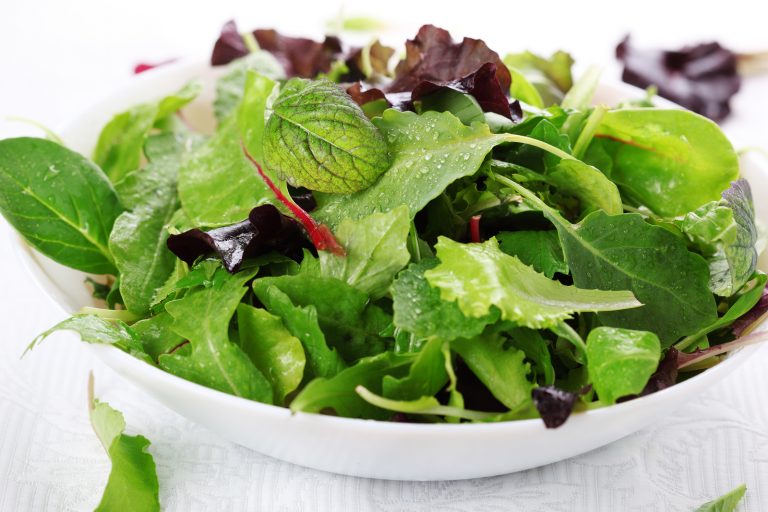Salad, once viewed as a side dish at meals – especially by the male of the species – has finally become a star at the dining room table! Much of this revolution is the result of increased cultivation of vegetables, especially salad greens, in place like Arizona. There, growers can operate year-round to deliver the freshest, most nutritious greens to regional and national kitchens.

photo: bigstock
As a result, salad is no longer a handful of pale and rapidly wilting lettuce cupped around a thimbleful of pale pink tomato chunks. Instead, it fashionably – and fearlessly – incorporates such exotic entities as arugula and radicchio (two words that are almost as much fun to say as they are to eat!).
This 21st century salad sophistication has, in some respects, gone overboard. At least where traditionalists are concerned. For them, the idea of an entire chicken breast in romaine hearts with marinated cucumber and shallot is weird, not wonderful.
Still, there’s no accounting for tastes in a generation that sees eggplant as passé. Today, the perfect salad is all-embracing. Use pinon nuts, olives, cherries, grapes, beans, chickpeas, tofu, cheese, bacon, even chunks of fish or steak. In fact, gently steamed bites of parsnip, beet, rutabaga, or sweet potato are not out of the question.
Dedicated salad lovers might even add mizuna or mesclun, that intriguing mix of tender, young greens. Others will go for frisée, which looks like fairy-frost in lettuce form. Old-fashioned sorts who are not intimidated by carbs, even in veggie form, will include some Arizona farm-fresh Brussels sprouts, bok choy, broccoli, or even tatsoi, not to mention spinach, scallions, leeks, celeriac, even oranges, tangerines and strawberries.
The history of salad is even more interesting than the potential list of ingredients. Did you know, for example, that salad:
- Is as old as Rome and Greece? It started out simple and graduated to include such exotics as Caesar salad (yep, direct from ancient Rome); Waldorf salad (originally apples and celery with mayonnaise dressing, from the famous London hotel of the same name); and Watergate salad – also named after the obvious; a 1970s American political conspiracy.
- Vegetables served raw, with dip, were once called crudités? The word is French, and means “rawness”. Thank goodness the English didn’t get hold of the word, or it might have turned out as “crud”, LOL!
- Comes from “sel”, the ancient word for salt? The word evolved to “salata”, meaning a salted herb, because salad-loving Romans dressed their raw veggies with oil, vinegar, and brine (a sort of salt-water solution).
- Was also once called Salmagundi, a meat and salad dish brought over to the American Colonies? Its transition to a Chef’s salad (lettuce, chicken, ox tongue, and smoked ham, in julienne strips) reportedly occurred at New York’s Ritz Hotel pre-World War II.
- Before the advent of refrigeration in the 20th century, garden greens not eaten the day they were picked were used up in “wilted” salads. Served with cooked chunks of bacon, “dressed” with bacon grease or oil, balsamic vinegar, sometimes even sugar, these salads are still very popular in some parts of the country and among canny cooks who will not discard day-old produce. Ever!
- With any form of pasta uses two separate dressings. Warm pasta uses vinaigrette. Cold macaroni salad uses mayonnaise or salad dressing. The distinction is less about style than safety. Vinaigrette will not spoil in warm weather or if left out. Mayonnaise or salad dressing, because of the eggs, will.
Modern day recipes, or adaptations of old ones, can be found on Fill Your Plate under the “recipes” tab. From there, you can choose from popular ingredients, most for sale at your local grower or farmer’s market, especially if you live in Maricopa, Pinal, or Yuma counties. Alternatively, you can search the more comprehensive drop-down list, which seems to have every item under the sun!
However you prepare your salad, put it in the refrigerator immediately before and after serving. This guarantees freshness and safety!
Related articles
- Cause a Stir with these Sensational Salads (fillyourplate.org)
- Spring for Salad! (fillyourplate.org)
- Green is the Color of Food Trends in Arizona for 2015 (fillyourplate.org)

